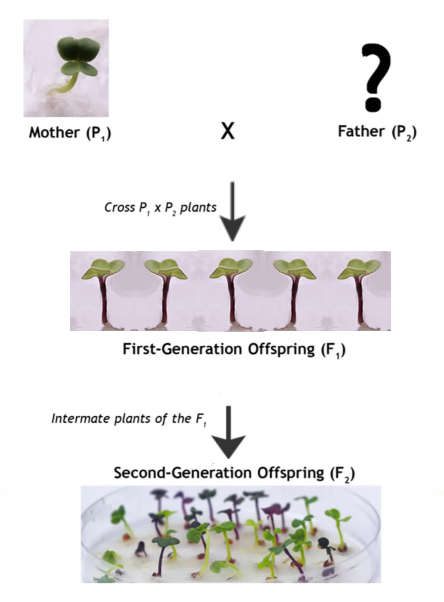
Teaching genetics to middle school students? Middle school genetics, aligned with Next Generation Science Standards* (NGSS), focus on the relationship between what can be observed (phenotype) and a general understanding of the underlying genetics. Rather than diving deep into cellular specifics, middle school genetics is taught at the organism level with a focus on phenotypes and genotypes and how they are related. In doing this, teachers lay a solid foundation for deeper understanding in high school and beyond.
Both middle and high school students need to grasp some pretty abstract concepts to understand genetics. That is why it’s so important to find ways to make concrete connections between observed traits and genetics. You can form these connections by using Wisconsin Fast Plants® in your genetics studies. Teaching with Wisconsin Fast Plants allows genetics lessons to be hands-on and can tangibly connect observable traits to the underlying genetics.
In this article, you’ll learn an approach for teaching genetics using Fast Plants. This approach explicitly connects phenotype and genotype by solving a mystery in which students:

- Notice how a mother plant with a non-purple stem has offspring with all purple stems (phenotypes).
- Brainstorm and draw diagrams with an imagined father plant that could possibly explain the observed inheritance pattern (genotypes).
- Predict what will happen if two offspring plants are inter-mated to produce a second offspring generation (genotype and phenotype).
- Germinate second generation seedlings and observe and record their stem color (phenotype).
- Revisit diagrams and revise to make sense of second generation’s stem colors (genotype).
Without needing to know specific vocabulary like phenotype or allele, this mystery-driven investigation supports students to learn meiosis fundamentals and interpret dominant/recessive inheritance patterns. To solve this Who’s the Father? Fast Plants mystery, students develop foundational understandings of meiosis and the relationship between phenotype and genotype.
A Phenomenon-Driven Genetics Investigation
Naturally, an inheritance pattern that cannot be easily explained is a mysterious, engaging phenomena. Such a phenomena can motivate students to figure out underlying causes and explain why this is happening. The phenomenon driving students’ curiosities in the Who’s the Father? Fast Plants investigation is a discrepancy between stem colors in a mother plant and her offspring (which is caused by a Mendelian inheritance pattern). Curiosity follows naturally, as students imagine what stem color the father had and try to explain why no offspring share their mother’s stem color.
Making Sense of Inheritance Patterns in Middle School
Teach genetics with Fast Plants using the Who’s the Father? kit. This mystery engages students in a simplified version of Gregor Mendel’s discovery. Mendel brilliantly explained the phenomenon he observed—the inheritance pattern that can occur when parent peas from two different, true-breeding lines for a trait such as seed coat color are crossed, and resulting offspring show only one of the parents’ seed coat colors. Using logic and reasoning, along with data from repeated experiments, Mendel developed an explanatory model that included what would later be named meiosis, chromosomes, alleles, and more.
Similar to Mendel’s peas, in the Who’s the Father? investigation, students observe, gather, and makes sense of observable data with Fast Plants. By performing the lab, students form a deeper understanding about meiosis and alleles to explain the inheritance pattern observed across three generations of Fast Plants.
Teaching Middle School Genetics Through Modeling, Problem Solving, and Discourse

Rather than duplicating Mendel’s work, students are engaged in producing similar data to what Mendel observed. They are then guided through diagramming (modeling) and discussion to make sense of it.
As shown in Figure 3, students begin this investigation by observing and trying to explain how all of the offspring generation could have the same stem color, different from the mother plant. At this point, students’ initial explanatory models (diagrams) are created in a brainstorming atmosphere.
Next, in place of telling students how offspring receive half their genetic code from their mother and half from their father, the investigation prompts students to use their models to make a prediction. You’ll ask: What will happen if you intermate two parents from this offspring generation to produce a second generation?

Figure 4 shows an example diagram that a student may draw if they have some notion that code for stem color comes from the parents with the code from the father dominating (probing needed to determine if the student was thinking about meiosis). While this model does give a workable explanation for what has been observed so far, it may not accurately predict what stem colors to anticipate in the next generation (depending on details not included in the diagram).

Finally, you will show students the F2 generation[1] and use the results to respectfully challenge their initial models. At this time in the investigation, it’s essential to facilitate effective discussion to challenge students’ naive ideas and deepen their understanding. For help with sentence stems and suggestions for probing questions, we recommend the Ambitious Science Teaching Discourse Primer, a free online resource. In particular, the primer’s section on discourse moves includes helpful support for pressing students to identify the flaws in their diagrams.
Figure 5 shows an example of a possible prediction made with the sample student model in Figure 4. This inaccurate prediction shows the importance of “solving the mystery” as a class. That way, students can all contribute to creating a single, updated diagram that accurately explains observations in the F2 generation. Then, through discussions during the final diagramming process, you may press with prompts such as: “It sounds like you have the start of an explanation for why there are more purple stems in the F1 and F2 generation, but isn’t there something missing that would explain the non-purple stems in some of the F2 offspring?” In this way, students are guided to solve the Who’s the Father? mystery, developing basic understandings of genetics by way of a compelling puzzle about the relationship between phenotype and genotype.
Related Products
How are traits passed from one generation to the next? In this 60-day investigation, students observe 3 generations of plants as they attempt to unravel the mystery of paternity. As the activity progresses, students develop explanations, based on their own observations, for the inheritance of either 1 or 2 Mendelian genes.
Students germinate seeds from P1, P2, F1, and F2 generations. They observe the seedlings from P1 and F1 and construct an inheritance pattern model to predict the phenotype and genotype of P2 and what the F2 seedlings will look like. After they examine the actual P2 and F2 seedlings, they can revise their model and explain the results based on the data they collected. The driving question that students investigate is, “How do trait variations in Fast Plants® seedlings reveal inheritance patterns?” A pre-lab exercise presents a fictional scenario that introduces students to the phenomenon of phenotypic variation and gives students practice identifying an inheritance pattern.
Resources
Windschitl, M., Thompson, J. J., & Braaten, M. L. (2014). A discourse primer for science teachers – ambitious science teaching. A Discourse Primer for Science Teachers. Retrieved August 16, 2022, from https://ambitiousscienceteaching.org/wp-content/uploads/2014/09/Discourse-Primer.pdf
*Next Generation Science Standards® is a registered trademark of WestEd. Neither WestEd nor the lead states and partners that developed the Next Generation Science Standards were involved in the production of this product, and do not endorse it.






